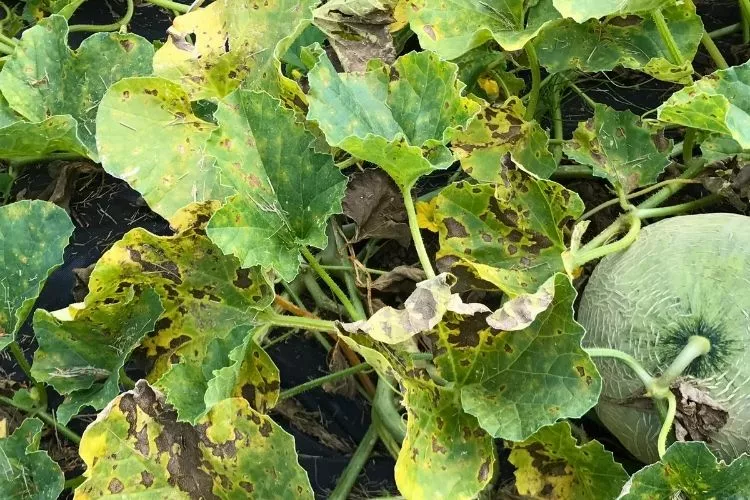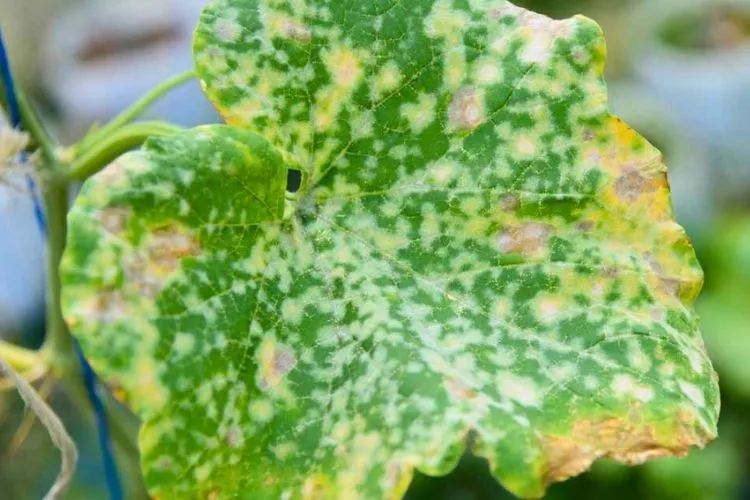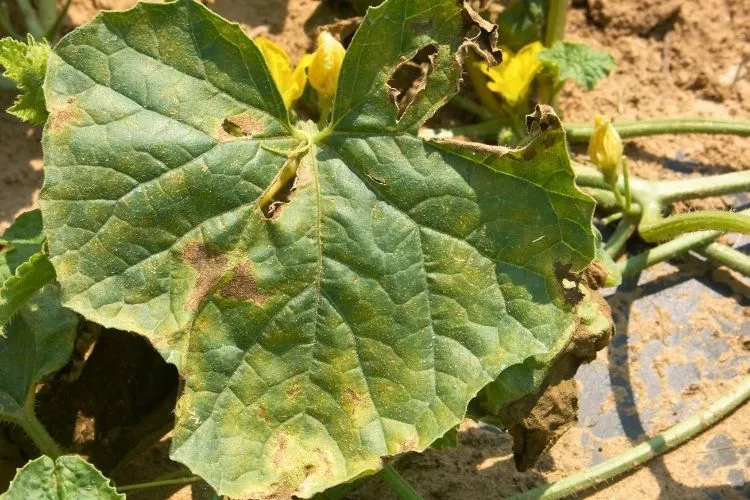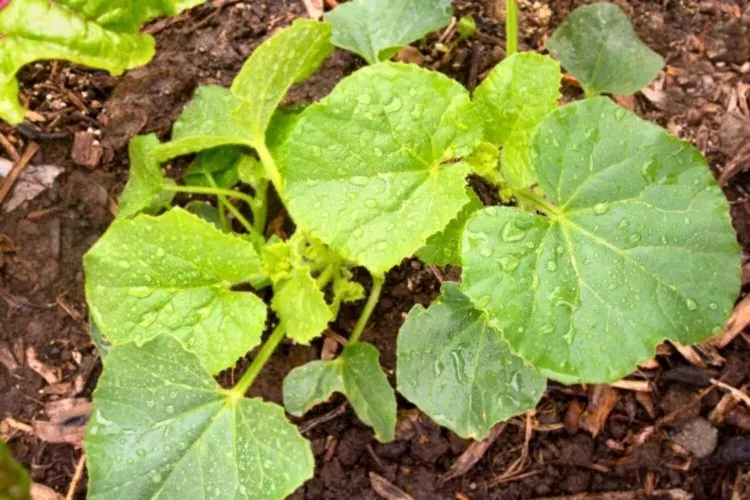Understanding the health of your garden can often feel like deciphering a complex botanical puzzle. One common issue of cantaloupe leaves turning yellow troubles all the gardeners frequently .
In this article, we delve into the root causes behind this phenomenon and deliver insights into preventive measures and remedies.

Enhance your gardening skills and ensure a healthier, more bountiful harvest by exploring the intricacies of cantaloupe leaf discoloration.
7 Reasons of Cantaloupe leaves turning yellow
Cantaloupe leaves may turn yellow for various reasons, including nutrient deficiencies, environmental factors, and diseases. To maintain a healthy and productive garden, it’s essential to identify and address these factors as early as possible. Here, we discuss some of the most common reasons for cantaloupe leaves turning yellow in detail.
Nutrient Deficiencies
Cantaloupe plants may display yellowing leaves when they lack essential nutrients. The most common deficiencies include:

- Nitrogen deficiency: Pale yellow leaves are often a sign of nitrogen deficiency, usually more pronounced in older leaves. To resolve this issue, you can use a high-nitrogen fertilizer or a balanced one like 10-10-10 (N-P-K) to replenish lost nutrients.
- Iron deficiency: When young leaves and veining appear yellow, it may indicate an iron deficiency. Provide appropriate chelated iron supplements to address this problem.
Watering Issues
Improper watering can significantly impact the health of your cantaloupe plants. Overwatering and underwatering can both lead to yellowing leaves:
- Overwatering: Excessive watering can cause root rot, depriving plants of oxygen and leading to yellow leaves. It is essential to maintain good drainage and watering practices by allowing the soil to dry slightly between waterings.
- Underwatering: Insufficient watering can cause the plants to wilt and become stressed, and subsequently, leaves may turn yellow. Monitor soil moisture levels and water consistently when the top inch of soil feels dry.
Pests
Several pests can cause cantaloupe leaves to turn yellow:
- Aphids: These small insects feed on plant sap, causing yellowing and curling leaves. Insecticidal soaps and neem oil are effective in eradicating aphids.
- Spider mites: Spider mites feed on the undersides of leaves, causing yellow spots. In cases of severe infestation, the leaves may fall off. Applying insecticidal soap or neem oil can combat these pests.
Diseases
There are a few diseases that can cause yellowing cantaloupe leaves, including:

- Fusarium Wilt: This is a soil-borne fungal disease that causes yellowing of lower leaves, followed by wilting and eventual death of the plant. Prevent fusarium wilt by practicing crop rotation, planting resistant varieties, and maintaining balanced soil pH.
- Powdery Mildew: This fungal disease causes a white, powdery substance on the leaf surface, which eventually leads to yellowing and defoliation. To manage powdery mildew, use fungicides, improve air circulation, and eliminate excess moisture on leaves.
By being vigilant and identifying the root cause behind yellowing cantaloupe leaves, you can address the problem effectively and ensure a thriving and bountiful garden.
Temperature Stress
Cantaloupes are warm-weather crops and they require a consistent temperature of around 70 to 90 degrees Fahrenheit for growth. Yellowing leaves can be a symptom of temperature stress:
- Cold Temperatures: When exposed to temperatures lower than what they prefer, cantaloupe plants can become stressed, leading to the yellowing of leaves. Heat mats or cloches can provide the needed warmth and protect the plant from cold.
- Heat Stress: Extremely high temperatures can also wreak havoc on your cantaloupes, causing leaves to scorch and yellow from excessive heat. Overhead watering or shading can provide relief from heat stress.
Light Stress
Similar to other plants, cantaloupes use sunlight for photosynthesis. However, cantaloupes being sun-loving plants, when deprived of full sun (at least 6 hours a day), can show signs of stress, including yellowing leaves. To prevent this:
- Place your cantaloupes where they can receive the required sunlight.
- If growing indoors, use grow lights to supplement natural light.
Aging and Natural Senescence
Over time, cantaloupe leaves, especially those closer to the base, may naturally yellow and wither as part of their life cycle. This process, called senescence, is a part of the plant’s preparation for the subsequent growing season:

- It is crucial not to confuse this natural yellowing with signs of disease or nutrient deficiency.
- Regular pruning and removal of these old leaves can help focus the plant’s energy on new growth and fruit production.
These factors, along with those discussed previously (like nutrient deficiencies, watering issues, pests, and diseases), complete a comprehensive view of why cantaloupe leaves might turn yellow. It is important to observe these symptoms closely to diagnose the problem timely and take necessary action for a healthy harvest.
How do you fix yellow leaves on plants?
Yellow leaves on plants can indicate various issues, from improper watering and nutrient deficiencies to pests and disease infestations. Identifying the cause behind the yellowing is crucial to resolve the problem effectively. This detailed guide will walk you through the steps to diagnose and fix yellow leaves on your plants.

Assess Symptoms and Identify the Problem
Inspect the plant thoroughly and observe the specific symptoms of the yellow leaves:
- Older leaves lower on the plant turning yellow: Likely nutrient deficiency or water-related issues.
- Yellowing primarily in younger leaves at the top of the plant: Possible iron or sulfur deficiency.
- Whole plant yellowing: Potential issue with nitrogen deficiency, excess watering, or inadequate sunlight.
- Spots or patterns on yellow leaves: It may suggest the presence of pests or diseases.
Once you’ve observed the symptoms, narrow down the possible causes by considering the plant’s growth conditions, the type of plant, and the time of year. Each of these factors can impact the plant’s susceptibility to specific issues.
Treat Nutrient Deficiencies
Nutrient deficiencies are a common cause of yellow leaves. Depending on the symptoms you’ve observed, take the following steps to address the deficiencies:
- Nitrogen deficiency: Apply a nitrogen-rich fertilizer or an N-P-K balanced one (for example, 10-10-10). You can also use compost, manure, or blood meal as organic alternatives.
- Iron deficiency: Apply chelated iron supplements to rectify this issue. Maintaining healthy soil pH (between 6.0 and 6.5 for most plants) can also optimize iron uptake.
- Sulfur deficiency: Use Epsom salt or gypsum to add sulfur to the soil.
Make sure to follow the recommended dosages and application guidelines while using supplements and fertilizers.
Adjust Watering Practices
Yellow leaves can also result from improper watering. Determine whether you’re overwatering or underwatering your plants and then adjust your watering schedule accordingly:
- Overwatering: Allow the soil to dry slightly between waterings. Ensure that your plants have proper drainage to avoid waterlogged conditions.
- Underwatering: Water consistently and avoid letting the soil dry out excessively. Incorporate mulch to help retain moisture in the soil.
Address Sunlight and Temperature Requirements
Different plants have varying sunlight and temperature needs. Ensure that your plants receive enough light and are not exposed to extreme temperatures:
- Inadequate Sunlight: Move your plants to a sunnier location or supplement with grow lights if needed.
- Temperature Stress: Protect your plants from cold by using heat mats, cloches, or relocating them indoors. Shield them from extreme heat by providing shade or overhead watering to reduce heat stress.
Combat Pests and Diseases
Yellow leaves can also signify the presence of pests or diseases. Take the following measures to address these issues:
- Pests: Use insecticidal soaps, neem oil, or other suitable treatments against aphids, spider mites, and other pests that can cause yellowing leaves.
- Diseases: Apply targeted fungicides when appropriate, and cultivate disease-resistant plant varieties. Practice good garden hygiene (removing infected leaves and debris), and promote healthy soil and air circulation to prevent fungal attacks.
Prune and Maintain Plant Health
Regularly prune dead, damaged, or yellow leaves to let your plant allocate energy more efficiently:
- When you notice that dead leaves are no longer transmitting nutrients, remove them from the plant.
- Be cautious when pruning to avoid damaging the stem or nearby healthy leaves.
By following this step-by-step guide, you’ll be better equipped to diagnose, treat, and prevent yellow leaves on your plants, ensuring a healthy and thriving garden.
How to Tell If Yellow Leaves are from Overwatering or Underwatering?
Diagnosing whether yellow leaves are due to overwatering or underwatering can be a bit tricky because both conditions often manifest as yellow leaves. However, there are some distinguishing signs you can observe.

Overwatering
- Soggy Soil: If the soil remains soggy or waterlogged for a long time after watering, it is a sign of overwatering. Overwatered plants often have extremely moist soil.
- Wilting Despite Water-Logged Soil: If the plant exhibits wilting leaves that appear soft and limp, despite the soil being saturated, this could imply the plant receives too much water.
- Root Rot: Over time, overwatered plants can develop root rot – a fungal condition that destroys roots due to excess moisture. This results in yellow leaves, stunted growth, and eventual plant death. You might notice a foul smell from the soil too.
- Edema: When plants absorb more water than they can use, their leaves may develop water-soaked blisters known as edema. These may eventually turn into corky brown scars.
Underwatering
- Dry Soil: If the soil dries out quickly or feels dry to a depth of 1 to 2 inches, chances are the plant is being underwatered.
- Crispy Leaves: Underwatered plants often show signs of wilting, and the leaves might feel crispy to the touch, especially around the edges and tips. In contrast to overwatered plants, the wilted leaves often feel dry and brittle.
- Slow Growth: Underwatered plants usually exhibit stunted growth due to inadequate water to transport nutrients.
By paying close attention, you can accurately determine whether your yellow leaves are due to overwatering or underwatering. Adjust your watering habits according to your diagnosis for healthy, green leaves.
Should I Cut Yellow Leaves Off?
Yes, removing yellow leaves can often be beneficial for your plants. Here are some reasons why:
- Redirects Energy: By removing yellow, brown, or dead leaves, you help the plant redirect its energy towards new, healthy growth.
- Prevents Disease Spread: Yellow or diseased leaves can become a breeding ground for pests and diseases. Removing them helps prevent the spread of these issues.
- Improves Photosynthesis: Yellow leaves are less efficient at photosynthesis. Removing them will allow more light to reach healthy, green leaves, thereby enhancing the plant’s photosynthesis.
- Better Aesthetics: Removing yellow leaves can help maintain the aesthetic appeal of plants by showcasing their healthy, vibrant foliage.
When cutting off yellow leaves, make sure to use sterile, sharp shears or scissors to make clean cuts. Do not rip the leaves off as that may cause damage to the plant. Always avoid excessive pruning in a single session as it can stress the plant.
Frequently Asked Questions (FAQs)
Can Yellow Leaves Turn Green Again?
Once a leaf starts to turn yellow, it cannot revert to being green again. The yellowing reflects a breakdown in chlorophyll, the molecule that gives leaves their green color, which typically indicates aging or stress. While you can’t reverse the process, you can treat the underlying cause of the yellowing to ensure new growth is healthy and green.
Can Too Much Fertilizer Turn Leaves Yellow?
Yes, applying too much fertilizer can turn leaves yellow. This phenomenon, called fertilizer burn, happens because excess fertilizer increases salt levels, causing the plant to lose water and desiccate. Symptoms include yellowing, browning, or even wilting leaves. It’s crucial to follow recommended fertilizer dosage and frequency to prevent such plant stress.
Do leaves turn yellow from not enough sun?
Leaves can turn yellow due to inadequate sunlight, as limited light can impede photosynthesis and lead to chlorosis, in which leaves start to lose their green pigment and turn yellow. However, yellowing leaves aren’t always a sign of inadequate sunlight. Other factors, such as overwatering and nutrient deficiencies, can also cause this condition. It’s crucial to correctly identify the yellowing cause before making adjustments.
Conclusion:
Yellowing cantaloupe leaves can indicate various issues, such as improper watering, nutrient deficiencies, inadequate sunlight, or pest and disease infestations.
It’s essential to carefully diagnose the problem and take remedial measures accordingly, making adjustments to the plant’s growing environment as needed.
By being proactive and addressing potential problems early on, you can ensure healthy growth and development of your cantaloupes and enjoy a bountiful harvest.


